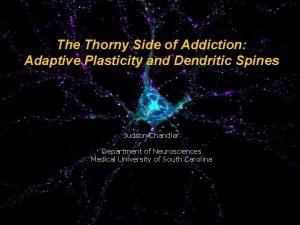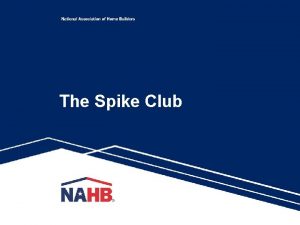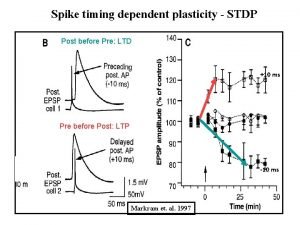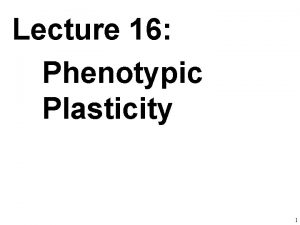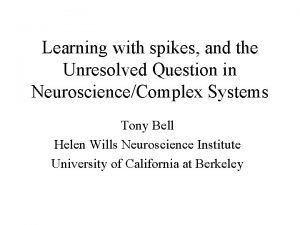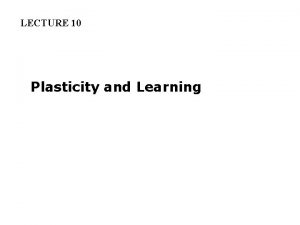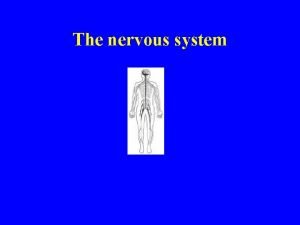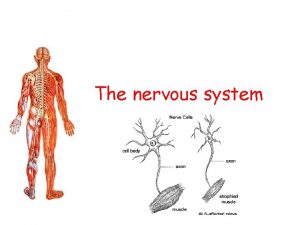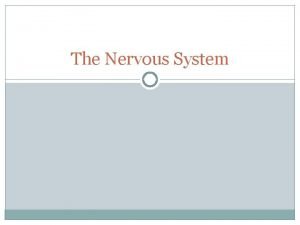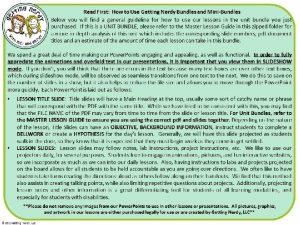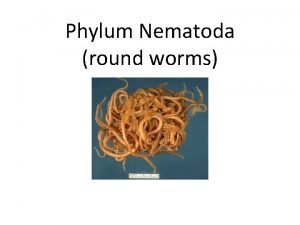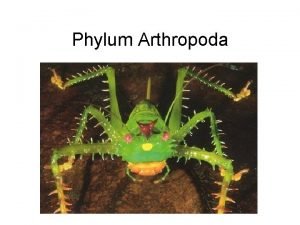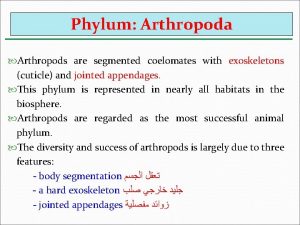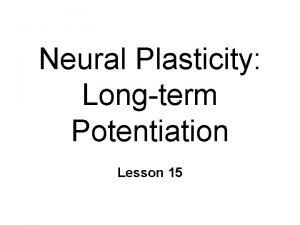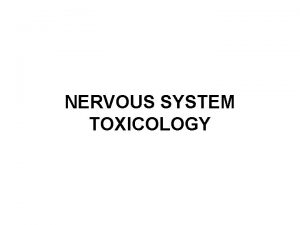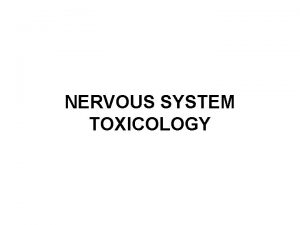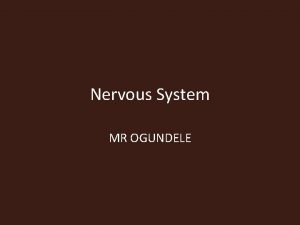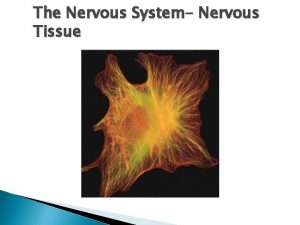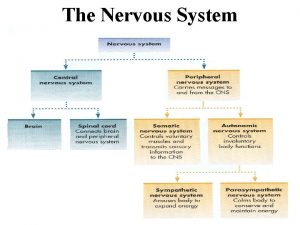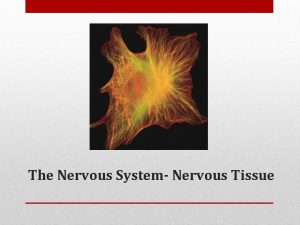Neural Plasticity Lecture 7 Neural Plasticity Nervous System




































- Slides: 36

Neural Plasticity Lecture 7

Neural Plasticity Nervous System is malleable l learning occurs n Structural changes l increased dendritic branching l new synapses n Changes in synaptic efficiency l Long-term potentiation l Long-term depression ~ n

Neural Mechanism of Memory Donald Hebb n Short-term Memory l Change in neural activity l not structural l temporary n Reverberatory Circuits l cortical loops of activity ~ n

Reverberating Loops n Maintains neural activity for a period l Activity decays ~

Hebb’s Postulate Long-Term Memory l required structural change in brain l relatively permanent n Hebb Synapse l use strengthens synaptic efficiency l concurrent activity required n • pre- & postsynaptic neurons ~

Long-term Potentiation According to Hebb rule l use strengthens synaptic connection n Synaptic facilitation l Structural changes l Simultaneous activity n Experimentally produced l hippocampal slices l associative learning also ~ n

Inducing LTP Stimulating electrode Perforant Pathway Record DG

Postsynaptic Potential Single elec. stimulation + -70 mv - 100 stim. burst Single stim.

Pattern Of Stimulation Strong, high frequency stimulation n Minimum stimulation l 1 + burst of 4 l 4 -7 Hz n • Theta l HC: Arousal & REM ~

LTP Duration Experimentally-induced LTP n Intact animals l seconds - months n HC slice l 40 hrs ~ n

LTP: Molecular Mechanisms Presynaptic & Postsynaptic changes n HC ---> Glutamate l excitatory n 2 postsynaptic receptor subtypes l AMPA ---> Na+ l NMDA ---> Ca++ n Glu ligand for both ~ n

NMDA Receptor N-methyl-D-aspartate n Glu binding opens channel? l required, but not sufficient n Membrane must be depolarized l before Glu binds ~ n

Single Action Potential Glu ---> AMPA l depolarization n Glu ---> NMDA l does not open l Mg++ blocks channel l no Ca++ into postsynaptic cell n Followed by more APs ~ n

Ca++ Na+ AMPA G G Mg NMDA

Mg Na+ AMPA G Ca++ G NMDA

Activation of NMDA-R n Ca++ channel l chemically-gated l voltage-gated Mg++ blocks channel n Ca++ influx --->post-synaptic changes l strengthens synapse ~

LTP: Postsynaptic Changes Receptor synthesis n More synapses n Shape of dendritic spines n Nitric Oxide synthesis ~ n

Before LTP Presynaptic Axon Terminal Dendritic Spine

After LTP Presynaptic Axon Terminal less Fodrin Less resistance Dendritic Spine

Nitric Oxide - NO Retrograde messenger l Hi conc. ---> poisonous gas n Hi lipid solubility l storage? n Synthesis on demand l Ca++ ---> NO synthase ---> NO n Increases NT synthesis in presynaptic neuron l more released during AP ~ n

NO c. GMP Glu Ca++ G NO NOS G Ca++

The Cerebellum & Long-term Depression Cerebellum Motor functions l Coordination of movements l Regulation of posture n Indirect control l Adjust outputs of descending tracts n Also nonmotor functions l memory/language ~ n

Cerebellum: Anatomy Folia & lobules l analogous to sulci & gyri n Vermis - along midline l output ---> ventromedial pathway n Hemispheres l output ---> lateral pathway n Deep cerebellar nuclei l fastigial, interposed, & dentate l Major output structures ~ n

Cerebellum n Programs ballistic movements l feed-forward control no feedback during execution direction, force, & timing l long term modification of circuits n Motor learning l shift from conscious ---> unconscious ~ l

Cerebellum Acts as comparator for movements l compares intended to actual performance n Correction of ongoing movements l internal & external feedback l deviations from intended movement ~ n

Cerebellum: 3 layered cortex n Molecular layer l parallel fibers l axons of granule cells runs parallel to long axis of folium n Purkinge cell layer l large somas l axons to underlying white matter perpendicular to main axis of folium ~

Cerebellum: 3 layered cortex n Purkinge cell layer l large somas l axons to underlying white matter l perpendicular to main axis of folium ~

Cerebellum: 3 layered cortex n Granular layer innermost layer l l small, densely packed granule cells > # neurons in cerebral cortex ~

Cerebellum: 3 layered cortex Molecular Purkinje Granule

Cerebellum: & Motor Learning Purkinje cells only output from cerebellar cortex l inhibit deep cerebellar nuclei n Input to Purkinje cells l Mossy fibers via parallel fibers n from spinal cord & brainstem nuclei l climbing fibers cerebral cortex & spinal cord via inferior olivary nucleus ~

Cerebellum: & Motor Learning n 1 Purkinje cell synapses. . l 1 each with 200, 000 parallel fibers l Many with 1 climbing fiber strong synaptic connections n Climbing fibers effects of mossy fibers transient ~

Cerebellum: 3 layered cortex Molecular Purkinje Granule Climbing fibers Mossy fibers

Cerebellum: & Motor Learning Long-term depression (LTD) l requires concurrent activity l climbing & parallel fibers active together l in activity of specific Purkinje cells n Climbing fibers may carry error signals l corrections ---> parallel fiber influence n input specificity l only affects active synapses of a parallel fiber ~ n

LTD Mechanisms n Similar to LTP l * changes are postsynaptic l Glutamate receptors

LTD Mechanisms *Requires concurrent activity n Climbing fiber 1. Ca++ *influx - voltage-gated n Parallel fibers activate 2. AMPA - Na+ influx 3. m. GLUR 1 n AMPA desensitized l Na+ influx ~ n

LTD Mechanisms m. Glu. R 1 l metabotropic l c. GMP-mediated l intracellular Ca++ stores l activation of phosphatases n Knockout mice l lack m. Glu. R 1 l loss of motor coordination ~ n
 Which neuron is rare
Which neuron is rare Fundamentals of the nervous system and nervous tissue
Fundamentals of the nervous system and nervous tissue Neuronal processes
Neuronal processes 01:640:244 lecture notes - lecture 15: plat, idah, farad
01:640:244 lecture notes - lecture 15: plat, idah, farad Graph neural network lecture
Graph neural network lecture Becker
Becker Unto us spike milligan
Unto us spike milligan Spike timing dependent plasticity
Spike timing dependent plasticity Adaptive plasticity
Adaptive plasticity Spikelihood
Spikelihood Consistency limit test
Consistency limit test Basalt
Basalt Plasticity
Plasticity Plasticity in earth's layers
Plasticity in earth's layers Nervous system and digestive system
Nervous system and digestive system Endocrine system vs nervous system
Endocrine system vs nervous system Mechanism of hormone action
Mechanism of hormone action Adh function
Adh function Chemical messengers of the nervous system
Chemical messengers of the nervous system Is flatworm asexual reproduction
Is flatworm asexual reproduction The nervous system is made up of
The nervous system is made up of Neuron anatomy
Neuron anatomy Nervous system learning objectives
Nervous system learning objectives Bipolar neuron function
Bipolar neuron function Stimulus in nervous system
Stimulus in nervous system Neuron bundle
Neuron bundle Adrenal gland sympathetic nervous system
Adrenal gland sympathetic nervous system Parasympathetic nervous system def
Parasympathetic nervous system def Nerve plexus
Nerve plexus Sns somatic nervous system
Sns somatic nervous system Brain scienstructable
Brain scienstructable Autonomic nervous system skeletal muscle
Autonomic nervous system skeletal muscle Phylum
Phylum Meristomata
Meristomata Jointed foot
Jointed foot Are arthropods coelomates
Are arthropods coelomates Major divisions
Major divisions





